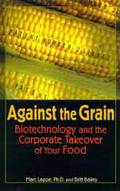Menu

More books on:
• environmental health
• ecofeminism
• peace and war
• globalization
• struggling against the odds
• seeking solutions
• others
Selected titles:

- "Biopiracy," by Vandana Shiva

- "Against the Grain," by Marc Lappe and Britt Bailey

- "Gene Wars," by Kristin Dawkins

- "Sharing the Harvest," by Elizabeth Henderson with Robyn Van En
Food sovereignty
Food sovereignty means having control over the production, amount and quality of our food. Can genetic engineering provide this? These books provide information -- and answers:
Biopiracy
The Plunder of Nature and Knowledge
Vandana Shiva
148 pages 1997
ISBN 0-89608-555-4 paper $13.00, ISBN 0-89608-556-2 cloth $40.00
Biopiracy is a learned, clear and passionately stated objection to the ways in which Western businesses are being allowed to expropriate natural processes and traditional forms of knowledge.
Praise for Biopiracy:
"Biopiracy is a path-breaking work on one of the most important issues of the coming century." --Jeremy Rikfin
"With her characteristic blend of analysis and passion, Vandana Shiva traces the continuity from the European colonization of 'native' peoples . . . to the present appropriation of the natural resources they need for their physical and cultural survival. An important book that should be read by anyone wanting to understand the global threat posed by the technological transformations of organisms, cells, and molecules and by their exploitation for profit."--Ruth Hubbard
Against the Grain
Biotechnology and the Corporate Takeover of Your Food
Marc Lappe, PhD and Britt Bailey
Common Courage Press, Monroe, ME 1998
163p. $14.95 ISBN 1-56751-150-3 Pb
Gene Wars
The Politics of Biotechnology
Kristin Dawkins
Seven Stories Press, New York 1997
60p. $4.95 ISBN 1-888363-48-7 Pb
Perfect for finding out about biotechnology while riding the bus. This handy booklet, part of the Open Media Pamphlet Series, looks at the political and social ramifications of increased dependence on genetically engineered seeds and plants: "we will see how a diversified gene pool is crucial to food production - and how corporate control of the gene pool threatens our collective security." Ms Dawkins explains how international agreements (globalization) have favored large agribusiness corporations, while driving farmers in the North America and small farmers overseas out of business. GATT, NAFTA, WTO and Trade-Related Intellectual Property Rights (TRIPS) are all explained in straightforward language. The final pages review the problems posed by development and promotion of genetically altered seeds and foods.
Are there advantages? "Recently," she writes, "the emphasis has been on developing plant varieties that can withstand massive doses of a company's own herbicide... As these chemical behemoths (the agribusiness corporations - ed.) use seeds, the essence of all future plant life, to fight for control of the herbicide market, a few naysayers ask: does society really need more chemicals to be used more widely on the farm?"
There is certainly enough information and questions here to make anyone wonder why we have to deal with this problem in the first place.
Can we do better, growing food locally for our communities?
Sharing the Harvest
A Guide to Community Supported Agriculture
Elizabeth Henderson with Robyn Van En
Chelsea Green Publishing Company, White River Junction, Vermont 1999
254 p. $24.95 ISBN 1-890132-23-2
Community Supported Agriculture is a connection between a nearby farmer and the people who eat the food that the farmer produces. Robin Van En summed it up as "food producers + food consumers + annual commitment to one another = CSA and untold possibilities." The essence of the relationship is the mutual commitment: the farm feeds the people, the people support the farm and share the inherent risks and potential bounty.
This inspirational and practical partnership between farmers and consumers has untold benefits. Money, jobs, and farms are kept in the community. Children grow up knowing how food is grown, and delight in eating fresh-off-the-vine tomatoes and greens and beans. Members with a great diversity of incomes and cultural backgrounds can transform their food-buying and eating habits. The interdependence between small-scale growers and loyal consumers takes us back to the past, as it also takes us forward to a new way of seeing the world.
This book is a hands-on, working manual, providing encouragement and practical advice to everyone interested in community supported agriculture. It is a terrific resource both for those new to the concept, and for seasoned farmers and advocates. You can refer to a specific chapter or you can study the whole book. There are first-hand accounts, sample budgets, share prices, crop selections, descriptions of all-farm workdays and celebrations. There are explanations of how CSAs contribute to a secure food supply and creative land stewardship, while strengthening the fabric of local communities. For farmers and consumers, as well as policy-makers, this book is compelling.
From the Goranson Farm in Maine:
"Community Supported Agriculture provides a mutually beneficial arrangement between farmer and community. In exchange for financial support in the spring from the 'shareholders,' the farmers commit to provide healthy, locally grown food throughout the growing season. The goal of the CSA is to reconnect people with the land and where the food they eat is grown, and they can learn to understand the complexities of providing this food. Joining a CSA leads to a greater awareness of our interdependence on one another and the land. It helps ensure the survival of rural life. Our farm has the ability to grow and provide food for a number of families while pursuing proper land stewardship. It is through the cooperation between farm and community that a sustainable food supply will become a reality."
The concept of community supported agriculture is highly adaptable, and CSAs show a wide range in their age, membership size, production methods, and involvement with the larger community. Most are less than a generation old, in the US and Canada, with shares varying from 3 to 800. Some are an extension of one farming family's operations, some have been started by people new to farming. Most are organic or Biodynamic, and most produce food for other markets - farmers markets, stores or restaurants - in addition to their membership. Members can pick up their share of the harvest at the farm, or they may have it delivered. "Like grapes or garlic, CSA takes on the flavor, bouquet, and integrity of where it grows, becoming appropriately adapted to each unique situation."
From Arctic Organics in Alaska:
"Community Supported Agriculture is an answer to what is becoming a worldwide concern: the production and distribution of high-quality, carefully produced food. By joining a CSA program you are supporting your food producers directly by avoiding the middlepeople (i.e., the distributor and retailer). You are purchasing organically and locally grown produce, thereby avoiding the high environmental and health costs and questionable merits of agricultural chemicals and the fossil fuels and other resources necessary for shipping it long distances. In exchange, you receive high-quality, nutrient-rich, flavorful produce on a weekly basis, freshly harvested the same day it's delivered."
From Winter Green Community Farm in Oregon:
"In many ways, the most important reason for any of us to be involved with the Community Farm is that it is an affirmation of the kind of world we want to live in. It is a positive choice for the future."
Author Elizabeth Henderson sums up the importance of CSA in this way: "Growing food is the most basic use of the natural resources of the Earth, and through food production, we make our own working landscapes. How each society or nation produces and distributes food in large measure determines its identity."
No matter what your background, you'll find "Sharing the Harvest" broadens your perspective about food production and consumption in a hopeful and supportive way.
-- review by Bonnie Acker, herself a working member of a CSA farm in northern Vermont

